The Drechslers of Münchsteinach
In the blog portion of this website I mentioned a wonderful adventure I had last month in Münchsteinach. My original intent was simply to expand on my investigation of the old Hasselbacher house on Neunstädter Straße. I am still looking for a better picture of this house in which Hasselbachers  lived from the mid-1700s until well into the 1800s. I was telling the Hasselbacher story to a new friend who, quite unbeknownst to me, turned out to be a history buff. He recognized the name of cousin Balthasar from his reading of church records and told me that Balthasar had done work on the mechanical workings of the church tower. Solely through the reputation of my new benefactor, I was able to climb the church tower to photograph the evidence! Normally the church tower is locked, and for good reason. The lighting is poor and the stairs are narrow! Nonetheless, a good story is worth a small risk. See also a short video of this experience on YouTube.
lived from the mid-1700s until well into the 1800s. I was telling the Hasselbacher story to a new friend who, quite unbeknownst to me, turned out to be a history buff. He recognized the name of cousin Balthasar from his reading of church records and told me that Balthasar had done work on the mechanical workings of the church tower. Solely through the reputation of my new benefactor, I was able to climb the church tower to photograph the evidence! Normally the church tower is locked, and for good reason. The lighting is poor and the stairs are narrow! Nonetheless, a good story is worth a small risk. See also a short video of this experience on YouTube.

I do not know exactly what this geared and ratchetted mechanical works represents. It is not functional now. I suspect it is a clockwork that controlled the ringing of the bells and/or a clock face as is currently on the exterior of the tower. These functions are controlled electrically today. It is my understanding that the wooden spools in the back of the apparatus were made by Balthasar. I do not understand their function. Perhaps they guided ropes that were used to hang weights or otherwise operate the mechanism. Perhaps one of you old clock-buffs will be able to inform us.

It was possible to see the channels that guided the ropes of old used to ring the bells. These appeared to be lined with a ceramic type material.
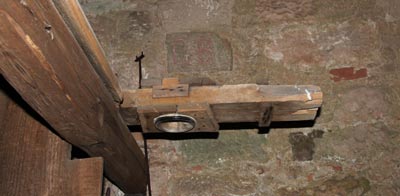
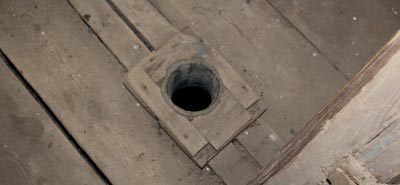
In the top of the tower on a metal frame home for bills. The biggest, from 1823 was also the oldest. It was made the year after Balthasar's death. One of the smaller bells had a date of 1951 on it. My guide informed me that the older small bells had been moved to a church in Neustadt.
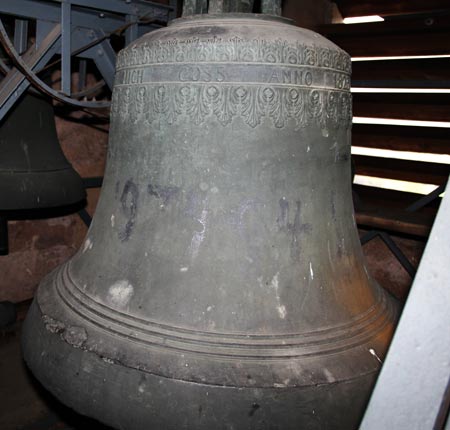
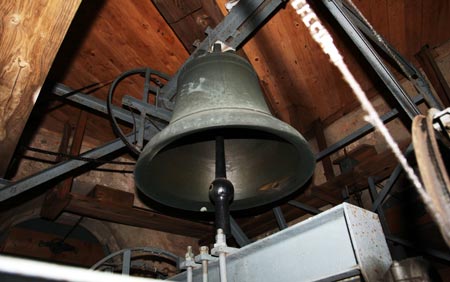 My hopes for taking panoramic photographs from the top were unrealized. Fixed wooden slats in the windows precluded that.
My hopes for taking panoramic photographs from the top were unrealized. Fixed wooden slats in the windows precluded that.
This was all very exciting, but it got even better. After I returned home, I received a letter from my new friend who must have returned to the archives and who provided us with the list of entries below. I present them in the original German, and with my potentially flawed translation. These items stimulate a number of points for discussion.
Anbei Stichpunkte aus den Jahren 1751 bis 1835:
- 1750 ist Drechsler Hasselbacher beauftragt einen neuen Ofenfuss zu machen.
- 1774 erhält Drechsler Hasselbacher 24 Kreuzer, für Walzen und Flaschen an die Kirchenuhr zu machen.
- 1774 am 6.10. stirbt Johann Georg Hasselbacher ein Drechsler, 64 Jahre und 1 Monat alt.
- 1772 32 Kreuzer dem Drechsler Hasselbacher für 3 1/4 tägiger Arbeit bei Orgelreparatur.
- 1776 dem Drechsler Hasselbacher für Arbeiten an der Kanzel 4 Gulden.
- 1779 dem hiesigen Drechsler Hasselbacher für die Drei Totenbahren auszubessern, l Gulden 10 Kreuzer.
- 1780 1 Gulden 24 Kreuzer dem Drechsler Hasselbacher, die Blasbälge der Orgel zu leimen, zu binden und zu beledern. Gleichzeitig zahlt Drechsler Hasselbacher für einige Stücke Bretter, die bei der Kanzel abgefallen sind,12 Kreuzer.
- 1781 1 Gulden 24 Kreuzer dem Drechsler Hasselbacher für 24 Seilwalzen auf dem Kirchturm zu fertigen.
- Die Arbeiten ab 1774 dürfte ausschließlich Balthasar Hasselbacher, der in den Archiven am öftersten genannt ist, ausgeführt haben.
Key points from the years 1751 to 1835.
- 1750: The turner Hasselbacher is commissioned to make a new oven-foot. (Offenfuss?)
- 1774: The turner Hasselbacher received 24 Kreuzer for rollers and bottles (Flaschen?) for the church clock.
- 1774: The turner Johann George Hasselbacher dies on October 6 at the age of 64 years.
- 1772: The Drechsler Hasselbacher is paid 32 Kreuzer for 3 1/4 work days to fix the organ.
- 1776: The Drechsler Hasselbacher receives four Gulden for work on the pulpit.
- 1779: The local Drechsler Hasselbacher receives 1 Gulden, 10 Kreuzer to repair three funeral biers.
- 1780: The Drechsler Hasselbacher receives one Gulden, 24 Kreuzer to glue, tie, and cover with leather the bellows for the organ. At the same time Drechsler Hasselbacher is paid 12 Kreuzer for several boards that had fallen off the pulpit.
- 1781: Drechsler Hasselbacher receives 1 Gulden, 24 Kreuzer for 24 rope rollers made for the church tower.
- The work since 1774 must have been done exclusively by Balthasar Hasselbacher whose name came up most often.
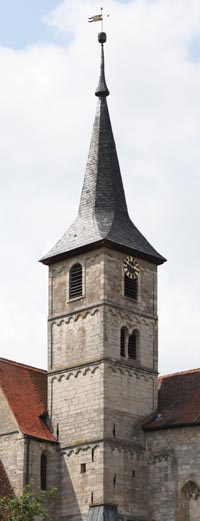 There were more than one Drechsler in Münchsteinach. The first was Balthasar's father, Johann Georg. To my knowledge, he was the first Hasselbacher with this skilled occupation. Johann Georg's father Christopher was a small farmer or at times even a day laborer. I have no knowledge of how Johann Georg would have acquired this trade. I assume he was apprenticed to someone. As the oldest son, Balthasar learned the craft and eventually became a Drechslermeister or Master Drechsler. Balthasar had a son, Peter, but I am presently unaware of his occupation. Balthasar had at least two brothers who survived to adulthood. The youngest was Johann Conrad (perhaps also known as Georg Konrad) who was born in 1763 and is described in later church records as a Drechsler. The middle son was of course, Peter, who became Peter Hazelbaker of America. It is reasonable to assume that Peter was also trained as a Drechsler.
There were more than one Drechsler in Münchsteinach. The first was Balthasar's father, Johann Georg. To my knowledge, he was the first Hasselbacher with this skilled occupation. Johann Georg's father Christopher was a small farmer or at times even a day laborer. I have no knowledge of how Johann Georg would have acquired this trade. I assume he was apprenticed to someone. As the oldest son, Balthasar learned the craft and eventually became a Drechslermeister or Master Drechsler. Balthasar had a son, Peter, but I am presently unaware of his occupation. Balthasar had at least two brothers who survived to adulthood. The youngest was Johann Conrad (perhaps also known as Georg Konrad) who was born in 1763 and is described in later church records as a Drechsler. The middle son was of course, Peter, who became Peter Hazelbaker of America. It is reasonable to assume that Peter was also trained as a Drechsler.
In the 1750 entry, the Drechsler referred to was certainly Johann Georg. Balthasar was born in 1754. By 1772, he would have been old enough to work with his father, and certainly after Johann Georg's death in 1774, the lead craftsman would have been Balthasar. I have no information on which to speculate what role, if any, younger brother Conrad might have played.
What did a Drechsler do? The direct translation is "Turner," but I suspect that this involved more than just turning a lathe. It is apparent from inspection of the list of jobs below, that Balthasar worked on a variety of wooden objects. Indeed, we already know that Balthasar was a carver of wood who was ornamenting churches in Münchsteinach and Stübach in as early as 1774.
I do not have a feeling for the value of the amounts paid for Balthasar's work. A Kreutzer is a silver coin. A quick Google search tells me that from the 1600s up until German unification in the 19th Century, 60 Kreutzers equaled one Gulden. In 1772, a Hasselbacher Drechsler (or perhaps Dreschlers) earned 32 Kreutzer for 3 1/4 days work repairing the organ.
I prepared a short movie containing video and stills of this adventure. It is available here on YouTube.
